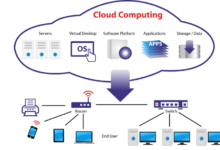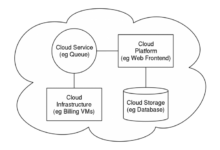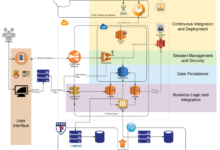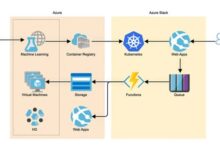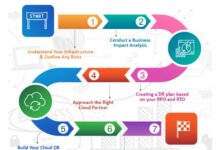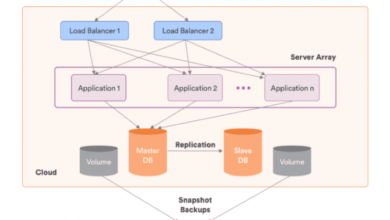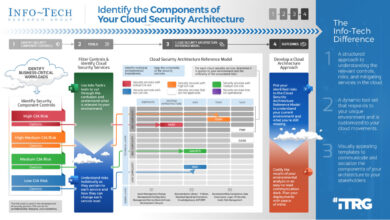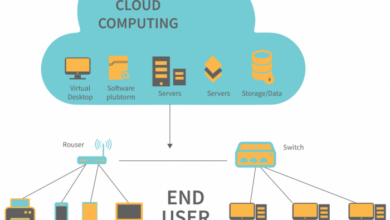How Cloud Architecture Diagrams Drive Efficiency in Cloud Systems: A Comprehensive Guide
In the realm of cloud computing, efficiency is paramount. Cloud architecture diagrams emerge as invaluable tools, providing a visual representation of cloud systems, enabling stakeholders to comprehend, manage, and optimize these intricate environments. This comprehensive guide delves into the significance of cloud architecture diagrams, exploring their role in enhancing efficiency, identifying inefficiencies, and driving better decision-making.
Cloud architecture diagrams serve as blueprints for cloud systems, offering a clear understanding of their components, interconnections, and data flows. These diagrams empower IT professionals to visualize the entire cloud infrastructure, facilitating proactive identification and resolution of inefficiencies. Real-life case studies illustrate how cloud architecture diagrams have led to substantial efficiency improvements, optimizing resource utilization, reducing costs, and enhancing performance.
Defining Cloud Architecture Diagrams
Cloud architecture diagrams are visual representations of the components and their relationships within a cloud computing system. They provide a comprehensive overview of the cloud infrastructure, its components, and how they interact.
The purpose of cloud architecture diagrams is to provide a clear and concise representation of the cloud system, making it easier to understand its design, functionality, and components. These diagrams are essential for architects, engineers, and IT professionals to effectively plan, design, and manage cloud-based solutions.
Types of Cloud Architecture Diagrams
There are various types of cloud architecture diagrams, each serving a specific purpose. Some common types include:
- Logical Architecture Diagrams: These diagrams illustrate the logical components of a cloud system, such as the relationships between applications, services, and data storage.
- Physical Architecture Diagrams: These diagrams show the physical infrastructure of a cloud system, including servers, networks, and storage devices.
- Deployment Architecture Diagrams: These diagrams depict the physical and logical components of a cloud system and how they are deployed in a specific environment.
- Security Architecture Diagrams: These diagrams illustrate the security measures and controls implemented in a cloud system, such as firewalls, encryption, and access control.
Efficiency Gains with Cloud Architecture Diagrams

Cloud architecture diagrams are essential tools for optimizing cloud systems, driving efficiency improvements, and ensuring optimal performance. By visually representing the components, relationships, and data flows within a cloud environment, these diagrams provide a comprehensive overview that enables stakeholders to identify inefficiencies, optimize resource allocation, and streamline operations.
Enhancing Efficiency in Cloud Systems
Cloud architecture diagrams contribute to efficiency gains in cloud systems in several ways:
- Improved Visibility and Understanding: Visualizing the cloud architecture enhances visibility into system components, dependencies, and data flows. This clarity facilitates a deeper understanding of the system’s behavior, enabling stakeholders to identify potential bottlenecks, inefficiencies, and areas for optimization.
- Optimized Resource Allocation: Cloud architecture diagrams help identify and allocate resources effectively. By understanding the resource requirements of different components and services, organizations can optimize resource allocation, ensuring that resources are utilized efficiently and cost-effectively.
- Enhanced Scalability and Elasticity: Cloud architecture diagrams enable organizations to design and implement scalable and elastic cloud systems. By identifying components that can be easily scaled up or down, organizations can ensure that their cloud infrastructure can adapt to changing demands and workloads, optimizing performance and minimizing costs.
Identifying and Resolving Inefficiencies
Cloud architecture diagrams play a crucial role in identifying and resolving inefficiencies within cloud systems:
- Bottleneck Identification: Visualizing data flows and dependencies helps identify potential bottlenecks that can hinder system performance. By analyzing the diagram, stakeholders can pinpoint components or processes that are causing delays or inefficiencies, enabling targeted optimization efforts.
- Resource Underutilization: Cloud architecture diagrams can reveal instances of resource underutilization, where certain components or services are not fully utilized. This insight allows organizations to optimize resource allocation, reducing costs and improving overall efficiency.
- Redundant Components and Services: Diagrams help identify redundant components or services that may be unnecessarily consuming resources. Eliminating these redundancies can streamline operations and improve efficiency.
Real-Life Case Studies
Several real-life case studies demonstrate the impact of cloud architecture diagrams in driving efficiency improvements:
- Company A: A multinational corporation used cloud architecture diagrams to optimize its cloud infrastructure, resulting in a 30% reduction in cloud costs. The diagrams helped identify and eliminate redundant services, optimize resource allocation, and implement autoscaling policies.
- Company B: A leading e-commerce platform utilized cloud architecture diagrams to improve the scalability of its cloud system. By identifying bottlenecks and implementing load balancing strategies, the company achieved a 20% increase in peak traffic capacity, enhancing customer experience and reducing downtime.
Benefits of Using Cloud Architecture Diagrams
Cloud architecture diagrams provide a visual representation of the cloud system, facilitating efficient management and decision-making. They offer a comprehensive overview of the system’s components, their interactions, and their relationships, enabling stakeholders to understand the system’s architecture, identify potential issues, and make informed decisions.
Advantages and Disadvantages of Cloud Architecture Diagrams
The following table compares the advantages and disadvantages of using cloud architecture diagrams:
| Advantages | Disadvantages |
|---|---|
| Enhanced understanding of cloud system architecture | Complexity in representing large and intricate systems |
| Identification of potential issues and bottlenecks | Difficulty in keeping diagrams up-to-date with changes |
| Improved communication and collaboration among stakeholders | Potential for misinterpretation if not properly documented |
| Support for decision-making and capacity planning | Time-consuming to create and maintain |
| Documentation of system architecture for future reference | Limited ability to capture dynamic aspects of the system |
Better Decision-Making in Cloud System Design
Cloud architecture diagrams contribute to better decision-making in cloud system design by providing a visual representation of the system’s components and their relationships. This enables stakeholders to:
- Identify potential issues and bottlenecks: By visualizing the system’s architecture, stakeholders can identify potential issues and bottlenecks that may affect the system’s performance or scalability.
- Evaluate different design options: Cloud architecture diagrams allow stakeholders to evaluate different design options and compare their advantages and disadvantages. This helps in selecting the most suitable design for the specific requirements.
- Make informed decisions about resource allocation: Cloud architecture diagrams help stakeholders make informed decisions about resource allocation by providing a clear understanding of the system’s resource requirements and how they are utilized.
Challenges in Creating Cloud Architecture Diagrams
Creating cloud architecture diagrams can be challenging due to various factors, including the complexity of cloud environments, the need for accuracy and consistency, and the dynamic nature of cloud infrastructure.
Some specific scenarios where creating cloud architecture diagrams can be challenging include:
- Rapidly changing cloud environments: Cloud environments are constantly evolving, with new services and technologies being introduced regularly. This can make it difficult to keep diagrams up-to-date and accurate.
- Complexity of cloud architecture: Cloud architectures can be highly complex, with multiple components and interdependencies. This complexity can make it difficult to create diagrams that are clear and easy to understand.
- Lack of standardization: There is a lack of standardization in the way that cloud architecture diagrams are created. This can lead to inconsistencies and confusion when diagrams are shared between different teams or organizations.
- Limited visibility: In some cases, it can be difficult to get a complete picture of a cloud architecture. This can be due to limited visibility into certain parts of the infrastructure or due to the use of multiple cloud providers.
To overcome these challenges, it is important to use a structured approach to creating cloud architecture diagrams. This includes using a consistent set of symbols and conventions, documenting the assumptions and constraints that were used in creating the diagram, and regularly reviewing and updating the diagram as the cloud environment changes.
Additionally, it can be helpful to use cloud architecture diagramming tools that can help to automate the process of creating and maintaining diagrams. These tools can help to ensure that diagrams are accurate and consistent, and they can also make it easier to share diagrams with others.
Best Practices for Cloud Architecture Diagrams
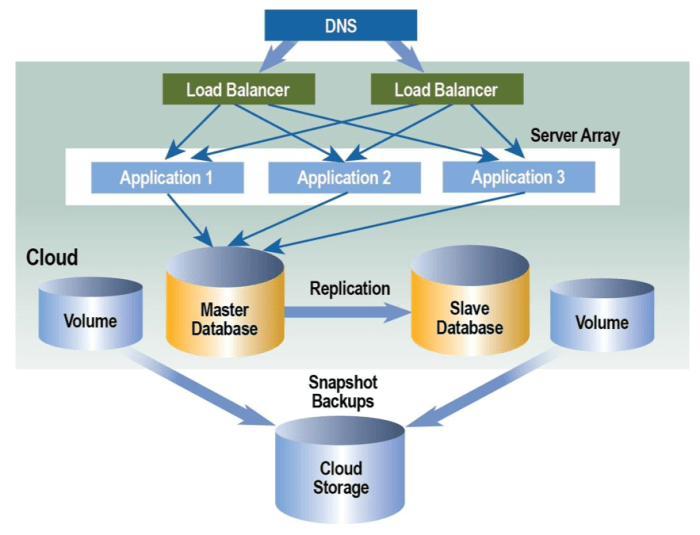
Creating effective cloud architecture diagrams is essential for successful cloud deployments. Here are some best practices to follow:
Standardization and Consistency
Standardization and consistency are key to creating effective cloud architecture diagrams. Establish a common set of symbols, colors, and conventions for all diagrams to ensure clarity and ease of understanding. This will help stakeholders quickly grasp the overall architecture and identify potential issues.
Choosing the Right Tools and Software
Choosing the right tools and software for creating cloud architecture diagrams is crucial. Consider factors such as ease of use, flexibility, and compatibility with your existing environment. Some popular tools include draw.io, Lucidchart, and Microsoft Visio.
| Best Practice | Explanation |
|---|---|
| Use standardized symbols and colors | Ensure consistency across all diagrams and make them easy to understand. |
| Create a legend | Provide a clear explanation of the symbols and colors used in the diagram. |
| Use clear and concise labels | Make sure labels are easy to read and understand. |
| Group related elements | Organize the diagram into logical groups to improve readability. |
| Use arrows to show relationships | Clearly indicate the flow of data or control between components. |
| Keep diagrams up-to-date | Regularly update diagrams to reflect changes in the architecture. |
Future Trends in Cloud Architecture Diagrams
Cloud architecture diagrams are continuously evolving to keep pace with the rapidly changing landscape of cloud computing. Emerging trends and innovations are shaping the future of these diagrams, enabling them to better meet the demands of modern cloud systems and provide valuable insights for architects, engineers, and stakeholders.
One significant trend is the adoption of artificial intelligence (AI) and machine learning (ML) techniques to automate and optimize the creation and management of cloud architecture diagrams. AI-powered tools can analyze vast amounts of data, identify patterns and relationships, and generate diagrams that are accurate, consistent, and up-to-date.
This can significantly reduce the time and effort required to create and maintain complex diagrams, allowing architects to focus on higher-level design and decision-making tasks.
Real-Time and Dynamic Diagrams
Cloud architecture diagrams are becoming more dynamic and responsive to changes in the underlying cloud environment. Real-time monitoring and analytics tools allow architects to track the performance and health of cloud systems in real-time and update diagrams accordingly. This enables proactive identification of potential issues, optimization opportunities, and compliance violations, helping organizations maintain a secure and efficient cloud infrastructure.
Collaboration and Integration
Collaboration and integration are becoming increasingly important in cloud architecture diagrams. Modern diagrams often incorporate elements from multiple sources, such as infrastructure diagrams, application architecture diagrams, and security diagrams. This requires effective collaboration among different teams and stakeholders to ensure that all aspects of the cloud system are accurately represented and aligned with business objectives.
Integration with other tools and platforms, such as cloud management platforms and DevOps tools, is also becoming more common, enabling seamless data exchange and automated updates.
Standardization and Best Practices
Standardization and the adoption of best practices are essential for creating consistent, high-quality cloud architecture diagrams. Industry standards and guidelines, such as the Cloud Adoption Framework (CAF) and the Open Group Architecture Framework (TOGAF), provide a common language and methodology for describing and documenting cloud architectures.
By adhering to these standards, organizations can ensure that their diagrams are easily understood and interpreted by all stakeholders.
Security and Compliance
Security and compliance are becoming increasingly important considerations in cloud architecture diagrams. Diagrams should clearly illustrate the security controls and measures in place to protect cloud systems from unauthorized access, data breaches, and other security threats. Compliance with industry regulations and standards, such as ISO 27001 and GDPR, is also becoming a key requirement for organizations operating in the cloud.
Cloud architecture diagrams can play a crucial role in demonstrating compliance and ensuring that the cloud environment is configured and managed in accordance with regulatory requirements.
Closure
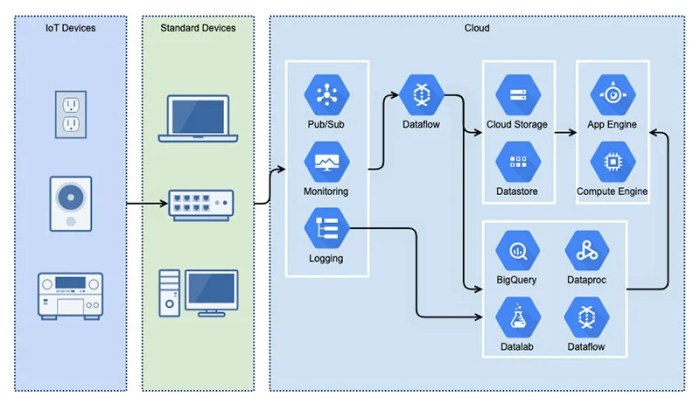
In conclusion, cloud architecture diagrams are indispensable tools for achieving efficiency in cloud systems. They provide a comprehensive visual representation of cloud environments, enabling stakeholders to gain insights, identify inefficiencies, and make informed decisions. As cloud systems continue to evolve, cloud architecture diagrams will adapt and incorporate emerging trends, ensuring their continued relevance in driving efficiency and optimizing cloud operations.
